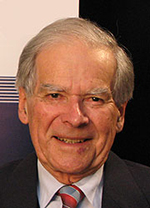
View Professor Ray Martin's photo gallery
You can order the DVD from the Academy for $15 (including GST and postage)
Professor Ray Martin was interviewed in 2008 for the Interviews with Australian scientists series. By viewing the interviews in this series, or reading the transcripts and extracts, your students can begin to appreciate Australia's contribution to the growth of scientific knowledge.
The following summary of Martin's career sets the context for the extract chosen for these teachers notes. The extract discusses some of his early work on compounds of rare metals found in the sands of Byron Bay. Use the focus questions that accompany the extract to promote discussion among your students.
Ray Martin was born in Melbourne in 1926. Enrolled in a combined engineering and science degree at the University of Melbourne, at the end of his second year he focused more on science. He earned a BSC in 1946. He received an MSc in 1948 on research into the oxides of rare metals. From 1949 to 1951 he was an Exhibition Scholar and studied at the University of Cambridge where he was awarded a PhD in 1952. His doctoral research investigated compounds made with boron trifluoride. He stayed in Cambridge as a research fellow at Cambridge University, researching and playing tennis, until 1954. He received a ScD from Cambridge University in 1968.
In 1954, Martin returned to Australia as a senior lecturer at the University of New South Wales where he stayed until 1959. His research there was into the chemistry of metals and the application of physical techniques, including magnetism, to study their structure, shape and chemical behaviour. He left academia to work in industry at ICI from 1959 to 1962.
From 1962 to 1972, Martin was professor and head of inorganic chemistry at the University of Melbourne. He helped set up the inorganic department at the university and his research continued to focus on the chemistry of metals. In 1972 he moved to the ANU as foundation professor of inorganic chemistry in the Research School of Chemistry. In 1978 he received a DSc from the ANU.
Martin returned to Melbourne in 1977 to become vice-chancellor of Monash University, a position he held until 1987. He then was professor of chemistry at Monash University until 1991. During these years he was also chairman of the Australian Science and Technology Council (1988–1992).
Over his long career, Martin has received numerous awards including an honorary DSc from the University of Melbourne (1996). The Royal Australian Chemistry Institute has awarded him the Leighton Memorial Medal (1990), the Burrows Award (1978) and the HG Smith Medal (1968). He was made an Officer of the Order of Australia in 1987 and received the Queen Elizabeth II Jubilee Medal in 1977.
Martin was elected a Fellow of the Australian Academy of Science in 1997.
Then you went on to graduate work.
Yes. When I finished the third year for the BSc degree, I was fortunate that I'd done quite well – I'd got a double first in the two chemistries that I took – and I decided that I'd like to do some research. There was no PhD available in Australia at that time; the standard degree on offer was a Master of Science, which was not done by course work but was a research degree. So, in the fourth year, I enrolled for an MSc in chemistry. That took two years.
One of my lecturers in the undergraduate course had been JS Anderson – who later became a professor at Oxford and an FRS (Fellowship of the Royal Society), a very distinguished man – and because I had found him an enthusiastic and excellent lecturer I asked if I could do my MSc under his supervision. He said yes, and set the topic: to look into a class of compounds called, in chemistry, nonstoichiometric compounds. Most of the chemicals we deal with are 'stoichiometric', one-to-one. For example, salt has one sodium atom and one chlorine atom. That is nice. But there are classes of oxides and other materials that are 'nonstoichiometric'. They don't obey these simple rules and they have very strange formulae. JS Anderson was a specialist in this area, and I did my MSc on a problem of oxide compounds of so-called rare metals.
We all use transistors and sensors of various kinds, solid state devices, which use compounds based on nonstoichiometric solids. That is the field I was in, not to make transistors or semiconductors but to learn something more fundamental about the particular compounds I was working with. Of Australian interest is that the sands in Byron Bay (which often figures because Paul Hogan lives there, amongst other things) are monazite sands, absolutely loaded with rare metals. The problem I was given was to look at some of the rare metals from Byron Bay which form these nonstoichiometric compounds – a problem with a fundamentally Australian origin.
Select activities that are most appropriate for your lesson plan or add your own. You can also encourage students to identify key issues in the preceding extract and devise their own questions or topics for discussion.
© 2025 Australian Academy of Science